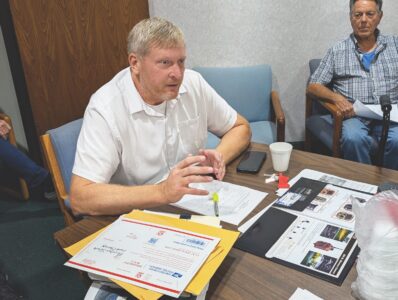Ohio EPA hosts early information session on proposed injection well

Diana Pierce, public information officer, communications and outreach for the Ohio Environmental Protection Agency, welcomes attendees to a meeting regarding a permit for a Class 1 injection well permit, Tuesday evening at Marietta High School. (Photo by Gwen Sour)
Over 100 people gathered in Marietta High School’s auditorium Tuesday evening as the Ohio Environmental Protection Agency held what they called an unusual, early-stage public information meeting on DeepRock Disposal Solutions’ request to drill an injection well in Washington County.
EPA officials emphasized the project is not yet at the draft permit stage and that a detailed technical review is just beginning.
“We haven’t made any decisions,” said Dina Pierce, Ohio EPA’s public information officer, communications and outreach. “We completed only a completeness review. If a draft permit is issued, we’ll return for a formal comment period.”
DeepRock is seeking permission to drill a Class I non-hazardous liquid waste injection well off Ohio 7 near Bramblewood Heights. According to a release from the Ohio EPA, the company operates five Class II injection wells for oil and gas brine, which are regulated by the Ohio Department of Natural Resources. The proposed Class I well would be regulated by the EPA.
“Class I non-hazardous injection wells … are regulated by Ohio EPA and allow companies to inject non-hazardous material,” said Mark Johnson, assistant director of the Ohio EPA. “Class II wells are regulated by ODNR and are limited to oil and gas brine.”
Johnson described safety precautions in place for the proposed construction – multiple casings cemented to the surface, continuous pressure monitoring, computerized supervisory control and data acquisition (SCADA) systems and automatic shut-off valves that trigger if pressures deviate from permitted ranges.
“If something is off – the pressure drops or is too high – systems shut down automatically and the company must notify Ohio EPA and ODNR,” he said.
Tim Hampel, a geologist for the EPA’s Division of Drinking and Ground Waters, outlined the permit-to-drill application process, saying the initial submission was on May 9 and the required $3,000 fee arrived June 3, which kickstarted the agency’s review. On June 13, the agency requested more information and DeepRock responded on Aug. 19 for its statutory input on geology, minerals, water resources and oil/gas resources.
Hampel said the EPA is now conducting a detailed evaluation of siting criteria, local and regional geology, proposed well construction, seismicity and financial assurance required to cover closure and contingencies.
Over a dozen residents, local officials and advocates voiced concerns about potential brine migrations, induced seismicity, cumulative pressure from many injection wells in the county and long-term accountability if contamination occurs.
Roxanne Groff, a self-proclaimed activist and former Athens County commissioner, urged an inter-agency investigation into reported migration incidents in southeast Ohio.
The United States Geological Survey defines migration as the “movement or migration of fluids, including petroleum and other chemicals through earth materials by natural or anthropogenic forces.” and seismicity as the “the geographic and historical distribution of earthquakes, encompassing the frequency, type, and size of earthquakes in a specific area over time.”
“Seven injection wells in southeast Ohio have already been suspended by ODNR for migration,” Groff said. “Only a 100% assurance, by denying this permit, can protect drinking water.”
Marietta City Councilwoman Erin O’Neill shared her concern about which agency would be responsible if problems surface in the future.
“Since these wells are intended as permanent disposal sites, who will be held responsible if contamination is detected in the future – the operator, the state or the taxpayers?” she asked.
EPA officials said operators must post financial assurance before drilling and file regular monthly and quarterly reports, with at least two inspections annually once operating. The agency noted it can collect samples as needed and will require an approved monitoring and testing plan before any operating permit is considered.
Erin Stevens, a resident of Washington County, shared her concerns regarding the state EPA monitoring the wells.
“With the current events of East Palestine, if we ask, the Ohio EPA is involved in that, and the C8 fiasco happened across the river, and it took years before people came out and people died, people had health (problems),” Stevens said. “Why should we trust you?”
Multiple speakers, including former Marietta Engineer Joe Tucker, cited recent earthquake clusters and a fault line paralleling the Ohio River, asking how additional injection could affect seismicity and whether Ohio EPA will consider ODNR-commissioned analyses on the issue. Officials said seismic surveys are required with the application and ODNR’s Division of Geological Survey is conducting an in-depth review of the applicant’s seismic materials at Ohio EPA’s request.
Attendees also asked why Ohio EPA’s public notice referenced the State Route 7 address when application maps place the well site south of that facility, closer to Bramblewood Heights. Pierce said the address reflects the facility and the well’s latitude/longitude is on file. They agreed the mapping error raised during the meeting will be flagged to the applicant.
Ohio EPA staff closed the session by underscoring that the agency is still gathering information. Officials said they are reviewing the completeness of DeepRock’s submission, cross-checking technical details and awaiting input from ODNR on geology, seismic activity and mineral resources.
Officials stated that If the agency develops a draft permit, residents will have another chance to weigh in through a formal public comment period and hearing. Until then, EPA representatives encouraged people to continue sending in data, technical reports and documentation that might inform the evaluation.
“We are very early in this process,” said Amy Klei, chief of the Ohio EPA’s Division of Drinking and Ground Waters. “Our role right now is to keep collecting information, review it thoroughly, and make sure we understand all of the potential impacts before any decision is made.”
Gwen Sour can be reached at gsour@newsandsentinel.com.



